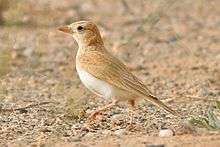Dunn's lark
Dunn's lark (Eremalauda dunni) is a small passerine bird of the lark family. It is a desert bird which is found across parts of the Sahara and Arabia.
| Dunn's lark | |
|---|---|
 | |
| Scientific classification | |
| Kingdom: | Animalia |
| Phylum: | Chordata |
| Class: | Aves |
| Order: | Passeriformes |
| Family: | Alaudidae |
| Genus: | Eremalauda WL Sclater, 1926 |
| Species: | E. dunni |
| Binomial name | |
| Eremalauda dunni (Shelley, 1904) | |
| Synonyms | |
| |
Taxonomy and systematics
Dunn's lark was originally described as belonging to the genus Calendula and has also been classified by some authorities as belonging to the genus Ammomanes.
Stark's lark was formerly also classified in the genus Eremalauda; it has since been moved to Spizocorys, leaving Dunn's lark as the only species in the genus Eremalauda.
Subspecies
Two subspecies are recognized:[2]
- Saharan Dunn's lark (E. d. dunni) - (Shelley, 1904): Found from Mauritania to central Sudan
- Arabian Dunn's lark (E. d. eremodites) - (Meinertzhagen, R, 1923): Originally described as a separate species in the genus Pyrrhulauda. Found from Syria to Jordan and through Saudi Arabia to Oman.
The latter taxon is recognised as a separate species, the Arabian lark (E. eremodites) in Handbook of the Birds of the World Alive and by Birdlife International.[3][4]
Description
Dunn's lark is a stocky bird with a large head and broad wings. It is 14 to 15 cm long with a wingspan of 25 to 30 cm.[5] The upperparts are pale sandy-brown with darker streaks. The underparts are whitish with some dark streaks on the breast. There is a pale stripe over the eye and a pale ring around it. Birds have dark moustachial and malar stripes and a dark mark under the eye. The short, broad tail is black below while the upperside is black with rusty-brown central feathers and pale outer feathers. The bill is large, heavy and pale pinkish or yellowish in colour. After moulting, the birds become gradually duller and the dark markings fainter as the plumage becomes more worn.[6]
The song is a scratchy warbling with short whistling phrases. Males sing either from the ground or in flight, hovering 30 metres or more above the ground.[5]
Distribution and habitat
In Africa, the species has a scattered range from Mauritania through Mali, Niger and Chad to Sudan.[7] In the Middle East, it breeds in Saudi Arabia and Oman. It has also bred occasionally in Jordan and Israel and may have bred in Yemen and the Sinai Peninsula of Egypt.[5][8] Vagrants have been recorded from Cyprus, Syria, Lebanon, Kuwait, Qatar and the United Arab Emirates.[5][9][10][11][12]
Dunn's larks are found in flat, arid areas with light vegetation such as grass and scattered bushes.[6]
Behaviour and ecology
Breeding
The nest is a scrape on the ground which is lined with vegetation. Two or three eggs are laid and are incubated for 13 to 16 days. They are white with blackish and lavender spots.[5]
Food and feeding
The diet mainly includes seeds and insects. Birds feed on the ground and sometimes dig for food with their bills. They typically feed in flocks outside the breeding season, moving nomadically in response to rainfall.[5]
References
- BirdLife International (2012). "Eremalauda dunni". IUCN Red List of Threatened Species. 2012. Retrieved 26 November 2013.CS1 maint: ref=harv (link)
- "IOC World Bird List 6.4". IOC World Bird List Datasets. doi:10.14344/ioc.ml.6.4.
- del Hoyo, J.; Collar, N. (2017). "Arabian Lark (Eremalauda eremodites)". Handbook of the Birds of the World Alive. Barcelona: Lynx Edicions. Retrieved 19 August 2017.
- BirdLife International (2017). "BirdLife International Checklist Version 9.1" (xlsx). www.birdlife.org. Retrieved 19 August 2017.
- Snow, D. W. & Perrins, C. M. (1998) Birds of the Western Palearctic: Concise Edition, Vol. 2, Oxford University Press.
- Harris, Alan, Shirihai, Hadoram & Christie, David (1996) The Macmillan Birder's Guide to European and Middle Eastern Birds, Macmillan, London.
- Sinclair, Ian & Ryan, Peter (2003) Birds of Africa south of the Sahara, Struik, Cape Town.
- Hollom, P. A. D., Porter, R. F., Christensen, S. & Willis, Ian (1988) Birds of the Middle East and North Africa, T & AD Poyser, Calton, England.
- "First record of African Dunn's Lark (Eremalauda dunni dunni) for the Tafilalt, Morocco" (PDF). Retrieved 20 March 2016.
- Serra G. (2005) "Dunn's Lark Eremalauda dunni - a first record for Syria", Sandgrouse, 27:77.
- Nation, Bob; Nation, Helen & Hooper, Helen (1997) Birds new to Qatar Archived 2008-05-26 at the Wayback Machine, Sandgrouse, 19.
- Richardson, Colin & Aspinall, Simon (1998) The Shell Birdwatching Guide to the United Arab Emirates, Hobby Publications.
